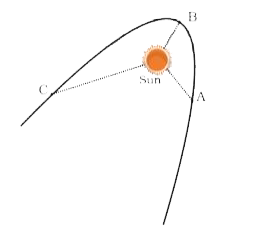(A ): The tails of comets are always oriented in a direction away from Sun (R) : Electromagentic waves exert pressure.Solution in Telugu
Both 'A' and 'R' are true and 'R' is the correct explanation of 'A'.
Both 'A' and ’R' are true and 'R' is not the correct explanation of 'A
A' is true and 'R' is false
'A' is false and R' is true
The correct Answer is:A
Step by step video, text & image solution for (A ): The tails of comets are always oriented in a direction away from Sun (R) : Electromagentic waves exert pressure. by Physics experts to help you in doubts & scoring excellent marks in Class 12 exams.
Topper's Solved these Questions
- BOOK - AAKASH SERIESCHAPTER - ELECTROMAGNETIC WAVESEXERCISE - EXERCISE -II20videos
ELECTROMAGNETIC WAVES
- BOOK - AAKASH SERIESCHAPTER - ELECTROMAGNETIC WAVESEXERCISE - EXERCISE -IA54videos
ELECTROMAGNETIC WAVES
- BOOK - AAKASH SERIESCHAPTER - ELECTROMAGNETIC INDUCTIONEXERCISE - Additional Exercise10videos
ELECTROMAGNETIC INDUCTION
- BOOK - AAKASH SERIESCHAPTER - ELECTROMAGNETICSEXERCISE - ADDITIONAL EXERCISE6videos
ELECTROMAGNETICS
Similar Questions
A parallel plate capacitor consists of two circular plates each of radius 2cm, separated by a distance of 0.1mm. If the potential difference across the plates is varying at the rate of 5×106Vs−1, then the value of displacement current is
03:10View SolutionThe idea of displacement current was introduced by
00:32View SolutionConsider Experiment II in Section 6.2.
a. What would you do to obtain a large deflection of the galvanometer?
b. How would you demonstrate the presence of an induced current in the absence of a galvanometer?03:06View SolutionWhat is the radius of the path of an electron (mass 9 × 10-31 kg and charge 1.6×x10–19 C) moving at a speed of 3×x107 m/s in a magnetic field of 6x×10−4 T perpendicular to it? What is its frequency? Calculate its energy in keV. (1eV=1.6×10−19J)
View SolutionA comet moves in a parabolic orbit with the sun as focus, when the comet is 2×107K.M from the sun, the line from the sun to it makes an angle π2 with the axis of the orbit. Find how near the comet comes to the sun.
View SolutionThe tail of a comet points away from the Sun due to
02:59View SolutionThe electromagentic waves do not transport
01:38View SolutionThe tail of Comet is
01:33View SolutionThe tail of Comet is
02:39View Solutionकथन 1 : एक धूमकेतु की पूँछ सदा सूर्य से दूर निर्दिष्ट होती है।
कथन 2 : धूमकेतु की पूँछ के कणों पर विकिरण दाब सूर्य द्वारा उत्सर्जित फोटॉन की गति की दिशा में होता है।01:08View SolutionWhich side of the comet's tail is on the sun?
View Solutionपुच्छल तारा (धूमकेतु) किसे कहते हैं?
02:13View SolutionWhat happens to the tail of a comet when it moves far away from the sun ?
View SolutionFig. 17.6 shows comets without their tail. Show the tails of the comets at position A, B, and C. In which position will the tail be longest?
 View Solution
View SolutionThe tail of a comet always points
01:46View Solution

